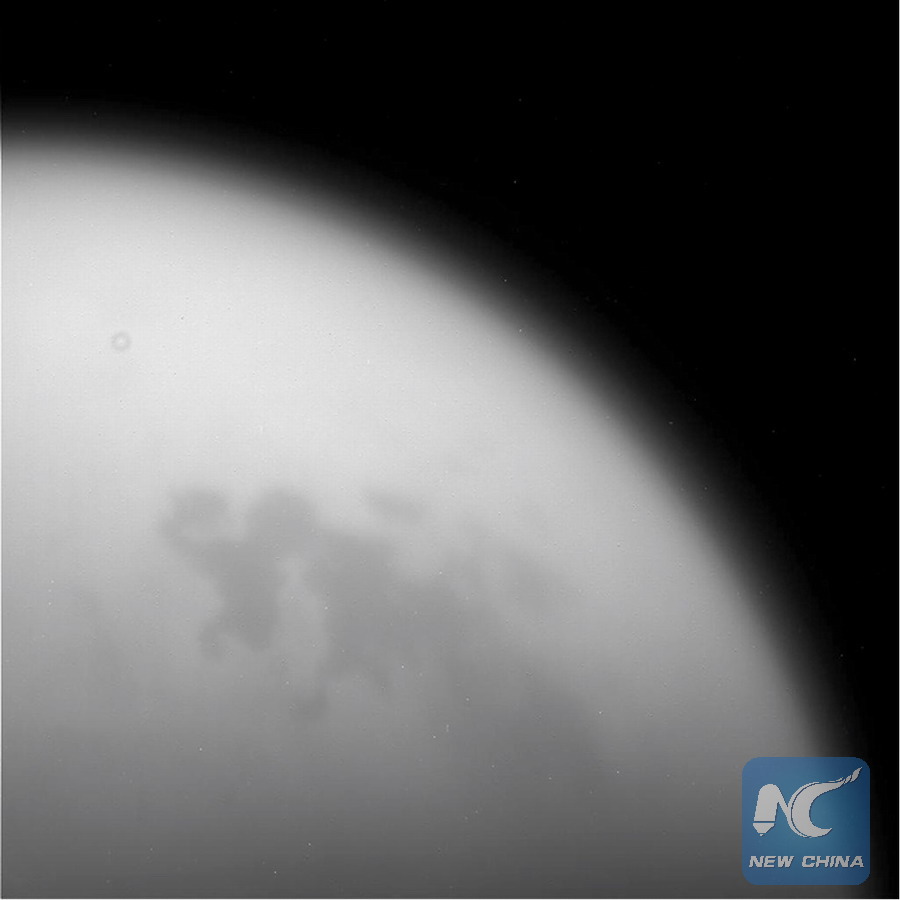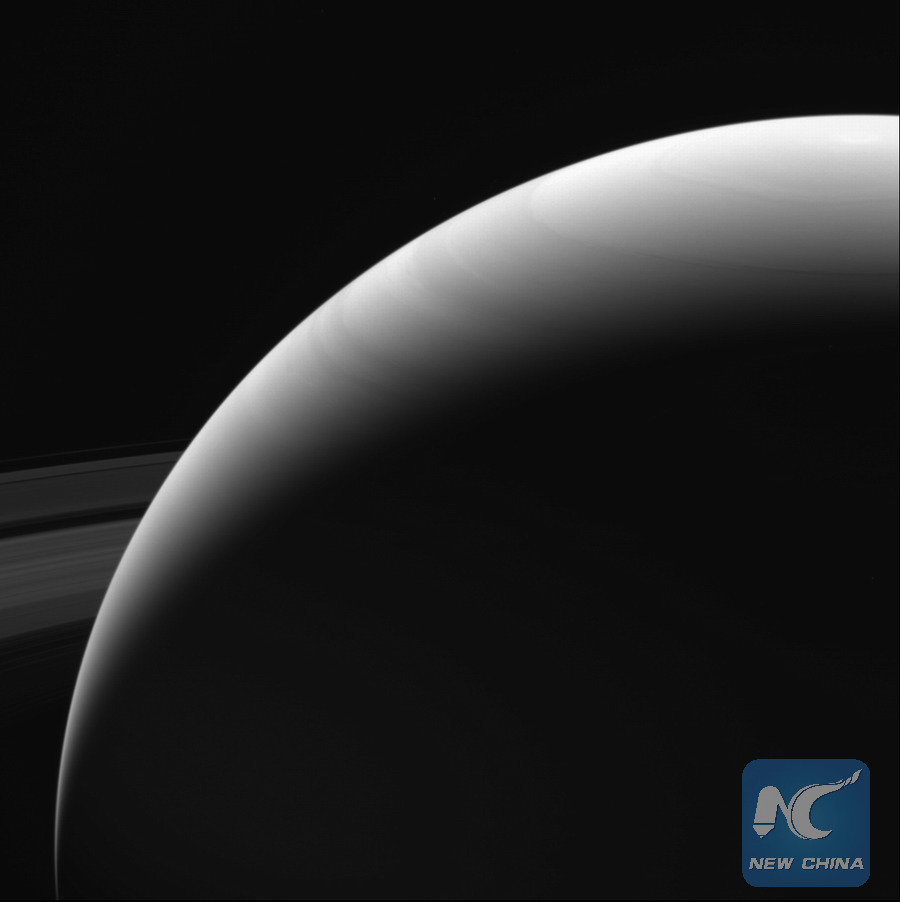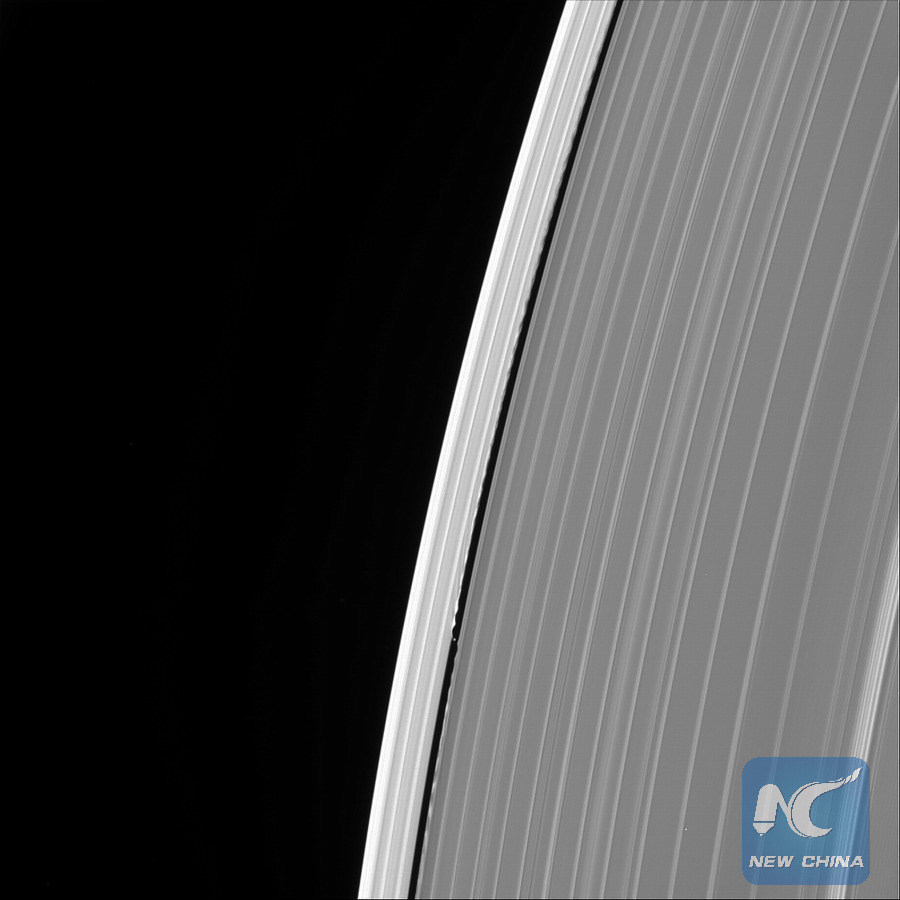
"Goodbye Kiss" Image of Titan. This unprocessed image of Titan was taken by NASA's Cassini spacecraft during the mission's final, distant flyby on Sept. 11, 2017. Credit: NASA/JPL-Caltech/Space Science Institute
LOS ANGELES, Sept. 15 (Xinhua) -- "Things never will be quite the same for those of us on the Cassini team now that the spacecraft is no longer flying," Linda Spilker, Cassini project scientist said in a statement.
"But, we take comfort knowing that every time we look up at Saturn in the night sky, part of Cassini will be there, too," Spilker added.
An amazing mission in the exploration of our solar system came to a close early Friday morning, as the U.S. National Aeronautics and Space Administration (NASA)'s Cassini spacecraft made a fateful plunge into the atmosphere of Saturn, ending its 13-year tour of the ringed planet.
Loss of contact with the Cassini spacecraft was confirmed at 4:55 a.m. PDT (1155 GMT), with the signal received by NASA's Deep Space Network antenna complex in Canberra, Australia.

This image of Saturn's northern hemisphere was taken by NASA's Cassini spacecraft on Sept. 13, 2017. It is among the last images Cassini sent back to Earth.
The view was taken in visible red light using the Cassini spacecraft wide-angle camera at a distance of 684,000 miles (1.1 million kilometers) from Saturn. Image scale is 40 miles (64 kilometers). Credit: NASA/JPL-Caltech/Space Science Institute
"I'm going to call this the end of mission," announced the Cassini program manager Earl Maize, who embraced with Julie Webster, spacecraft operations team manager, in an emotional moment for the entire Cassini team after the spacecraft plunged into Saturn at the agency's Jet Propulsion Lab (JPL).
"Congratulations to you all. This has been an incredible mission, an incredible spacecraft, and you're all an incredible team," Maize said to applause as the spacecraft began to break up in Saturn's atmosphere.
The explorer's termination was deliberate. Running low on fuel, the 13-year tour of the Saturn system mission must end. The spacecraft made a deliberate plunge into Saturn's atmosphere to avoid the small possibility of it crashing into a potentially habitable moon, in particular Enceladus.
As predicted, traveling at approximately 113,000 km per hour, Cassini begun its entry into Saturn's atmosphere at an altitude of about 1,915 km above the planet's estimated cloud tops at 3:31 a.m. PDT (1031 GMT), with a confirming signal received on Earth at 4:55 a.m. PDT (7:55 a.m. EDT).
At that speed you could travel from New York City to Los Angeles in less than three minutes, and it would take just over an hour to travel three times around the Earth at the equator.
Due to the travel time for radio signals from Saturn, which changes as both Earth and the ringed planet travel around the Sun, events have taken place there 83 minutes before they are observed on Earth.

This image of Saturn's outer A ring features the small moon Daphnis and the waves it raises in the edges of the Keeler Gap. The image was taken by NASA's Cassini spacecraft on Sept. 13, 2017. It is among the last images Cassini sent back to Earth. Credit: NASA/JPL-Caltech/Space Science Institute
across our solar system for nearly an hour and a half after Cassini itself has gone.
Within about 30 seconds following loss of signal, the spacecraft began to fall apart. About one minute later, engineers anticipate loss of contact.
Within a couple of minutes, all remnants of the spacecraft are expected to be completely consumed in Saturn's atmosphere. Cassini melted and vaporized.
The spacecraft burned up like a meteor, becoming part of the planet itself.
"Cassini is now part of the planet it studied," Cassini's team said on Twitter.
"It's a bittersweet, but fond, farewell to a mission that leaves behind an incredible wealth of discoveries that have changed our view of Saturn and our solar system, and will continue to shape future missions and research," Michael Watkins, director of NASA's Jet Propulsion Laboratory (JPL), said in a statement.
On its final orbit, the probe has even made groundbreaking scientific observations of Saturn. Before contact was lost, eight of Cassini's 12 scientific instruments were operating. In particular, the spacecraft's Ion and Neutral Mass Spectrometer (INMS) was directly sampling the atmosphere's composition, which cannot be done from orbit.
At 1:55 a.m. PDT (0831 GMT), engineers have received the signal that Cassini has started a five-minute roll to point the instrument that will sample Saturn's atmosphere (INMS) into the optimal direction, facing the direction of the oncoming gases, according to JPL.
Along with this roll, the spacecraft was reconfiguring its systems for real-time data transmission at a rate of 27 kilobits per second (3.4 kilobytes per second). Final, real-time relay of data started immediately after. That relay marks the beginning of Cassini's final plunge.
As planned, data from eight of Cassini's science instruments was beamed back to Earth, according to NASA. Mission scientists will examine the spacecraft's final observations in the coming weeks for new insights about Saturn, including hints about the planet's formation and evolution, and processes occurring in its atmosphere.
Cassini's plunge brings to a close a series of 22 weekly "Grand Finale" dives between Saturn and its rings, a feat never before attempted by any spacecraft.

As it glanced around the Saturn system one final time, NASA's Cassini spacecraft captured this view of the planet's giant moon Titan. Interest in mysterious Titan was a major motivating factor to return to Saturn with Cassini-Huygens following the Voyager mission flybys of the early 1980s. Cassini and its Huygens probe, supplied by European Space Agency, revealed the moon to be every bit as fascinating as scientists had hoped.
These views were obtained by Cassini's narrow-angle camera on Sept. 13, 2017. They are among the last images Cassini sent back to Earth.
Credit: NASA/JPL-Caltech/Space Science Institute
On Thursday afternoon, the spacecraft was in the process of emptying its onboard solid-state recorder of all science data, including the final images taken by its imaging cameras, prior to reconfiguring for a near-real-time data relay during the final plunge.
During its final journey, Cassini was sending back new and unique science to the very end.
"Cassini may be gone, but its scientific bounty will keep us occupied for many years," Spilker said. "We've only scratched the surface of what we can learn from the mountain of data it has sent back over its lifetime."
Launched in 1997, the 3.26-billion-U.S.-dollar Cassini-Huygens mission has been touring the Saturn system since arriving there in 2004. The Huygens lander separated from Cassini and plopped down on the surface of Saturn's moon Titan shortly after the arrival.
The Cassini probe had been scheduled to study the Saturn system until 2008, but the mission was given two extensions that stretched its lifetime into 2017.
During its journey, Cassini has made numerous dramatic discoveries. "Cassini's discovery of ocean worlds at Titan and Enceladus changed everything, shaking our views to the core about surprising places to search for potential life beyond Earth," Thomas Zurbuchen, associate administrator for NASA's Science Mission Directorate at NASA Headquarters in Washington, said in a statement.
"This is the final chapter of an amazing mission, but it's also a new beginning," Zurbuchen said.

